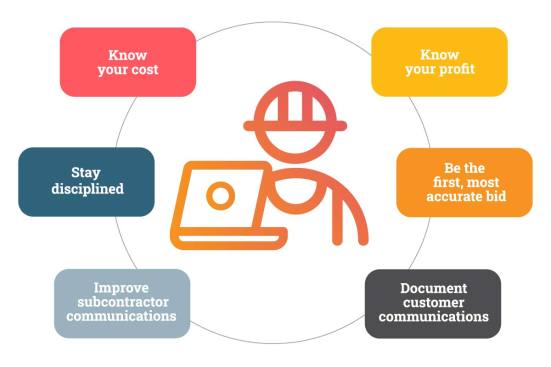While there is no shortage of troubling news in today’s home construction industry, successful builders know within difficult times lies opportunity. Now more than ever it’s important to arm yourself with the right business practices that see you through the hard times and give you a competitive edge.
While another hike in mortgage rates has cooled the US housing market, these same economic trends are also boosting demand for home improvement projects. The key to navigating these adverse effects is to find the right projects to strengthen and grow your business, and today’s construction management software helps you do this.
Below are some best practices for using software to navigate today’s turbulent economy:
1. Stay disciplined
It’s tempting to rush preconstruction tasks like estimating because they are so time consuming. Now, with modern construction estimating software, you can get this work done quickly, without being pinned behind the desk all day. Builders using construction management software have been able to complete takeoffs and send accurate quotes to customers up to 80% faster than they were before.
2. Know your costs
Find the right opportunities when you estimate accurately. Today’s successful custom builder responds to homeowners with a detailed estimate that lists all the required tasks. There should be no surprises as to the scope of work and costs. Complete construction management software also allows you to easily add markup to ensure you make money on the projects you bid.
3. Be the first in the door
Builders win more projects by being the first to answer homeowners with a bid. Digital takeoffs nail material counts in a fraction of the time that it takes to calculate with pencil and paper, and with construction management software you can be confident your material pricing is on point. Modern estimating software also integrates material catalogs so that accurate pricing is available at any time.
4. Keep your subcontractors in the loop
Construction management software builds a complete schedule straight from your first estimate. A complete schedule ensures your network of subcontractors is on-site with the right materials.
5. Document customer communication
With labor and material costs rising, you want to keep clear records of change orders. Today’s building estimating software allows you to easily share change orders with customers, so they know the impact on the project budget and schedule.
6. Know your profit
Finally, as you estimate common projects and tasks using software, you save more time by creating templates for future use. This frees up time for you to think more strategically about the quality of materials in your order and your profit margins.

Many builders, like Ryan McDonald of RYMAC Construction, have used construction management software, like Buildxact, to adopt several of these practices. With construction management software, they’ve continued to quote and win new work and keep their projects on budget and profitable amidst the constant change economic impacts are having on the housing market.
To learn more about how builders can use cloud-based software to create more accurate estimates in less time, visit Buildxact.



